MetLife, one of the largest global providers of insurance, annuities, and employee benefit programs, has strategically implemented Generative AI in its call centers to enhance customer support. By focusing on coaching agents for improved consumer interactions, MetLife’s tool uses Generative AI in insurance to deliver empathetic and efficient service. The technology is particularly impactful in sensitive discussions about life insurance, where understanding and addressing buyer concerns promptly is vital.
A report titled “Insurance 2030” from McKinsey & Co. illustrates a future where Generative AI will be one of the leading tech in the insurance industry. This shift from “detect and repair” to “predict and prevent” is rapidly becoming a reality, with the necessary technologies already in place.
Health insurance providers have been doing something very similar, with generative AI chatbots offering 24×7 consultation to insurers and addressing issues in real-time. This, in turn, not only provides customers with a better experience but also helps insurers save money on unnecessary settlement claims by managing risk effectively.
This transformation is significant, with the generative AI in insurance market projected to grow from $462.11 million in 2022 to around $8,099.97 million by 2032. For insurance leaders looking to embark on this journey, understanding “Getting started with generative AI” is crucial.
This guide aims to provide insights for various sectors, including banking, business, and business owners, offering a comprehensive roadmap for integrating generative AI into existing insurance practices.
Table of Content
- What is Generative AI?
- Understanding the Impact of Generative AI in the Insurance Industry
- Generative AI Challenges Faced By Insurance Companies
- Getting Started with Generative AI: A 5-Step Guide for Insurance Firms
- Case Studies of Successful AI Implementations in Insurance
- Top Generative AI Use Cases in the Insurance Industry
- Case Studies of Successful AI Implementations in Insurance
- Kanerika: Building the Future of Insurance with Generative AI
- FAQs
What is Generative AI?
Generative AI is revolutionizing industries globally with its ability to create content indistinguishable from that produced by humans. This technology, encompassing advancements in natural language processing and beyond, is poised to impact the global economy significantly.
Goldman Sachs Research underscores this transformative potential, predicting a 7% increase in global GDP (almost $7 trillion) over a decade, driven by generative AI’s integration into business and society.
This could also boost productivity growth by 1.5 percentage points. The technology’s capacity to generate human-like content and facilitate seamless human-machine communication marks a major economic and technological milestone.
But how can this technology help insurance companies grow? Let’s understand this in more detail.
Also Read – Automation In Insurance: Use Cases, Benefits, and Strategies
Understanding the Impact of Generative AI in the Insurance Industry
The insurance industry is undergoing a significant transformation thanks to generative AI. Deloitte points out that this technology is not just about repurposing existing data; it’s creating novel, creative outputs across various applications. Generative AI’s potential in insurance is vast, from enhancing customer interactions to optimizing internal processes.
In “horizontal” use cases, insurance companies are employing generative AI for tasks like dialogue generation in virtual assistants, automated code generation, and creating marketing content.

This cross-industry application allows for improved speed to market and the adoption of advanced capabilities.
The real game-changer, however, lies in “vertical” use cases specific to the insurance sector.
These applications require deep industry knowledge and often involve fine-tuning existing models or developing specialized ones. The goal is to integrate various generative AI applications into a seamless, scalable end-to-end solution.
For instance, in Property and Casualty (P&C), generative AI streamlines claim processing, enhances productivity, and drives cost savings. In Life and Annuity (L&A), it’s used for product personalization, agent assistance, and optimized underwriting.
Group insurance benefits from customized plans and improved member engagement, leading to new revenue streams and increased productivity.
Benefits of Gen AI for Insurance
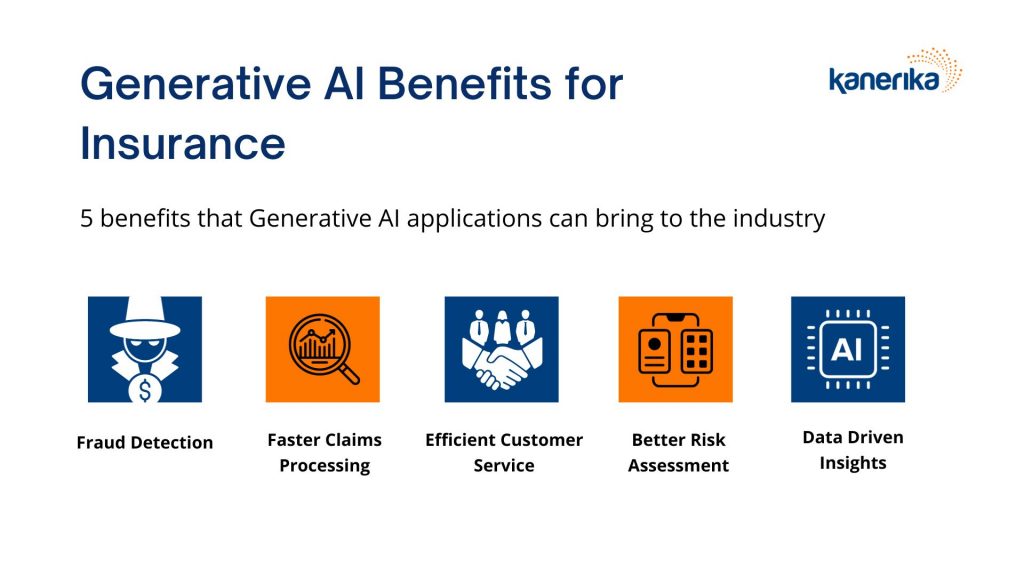
Generative AI Challenges Faced By Insurance Companies
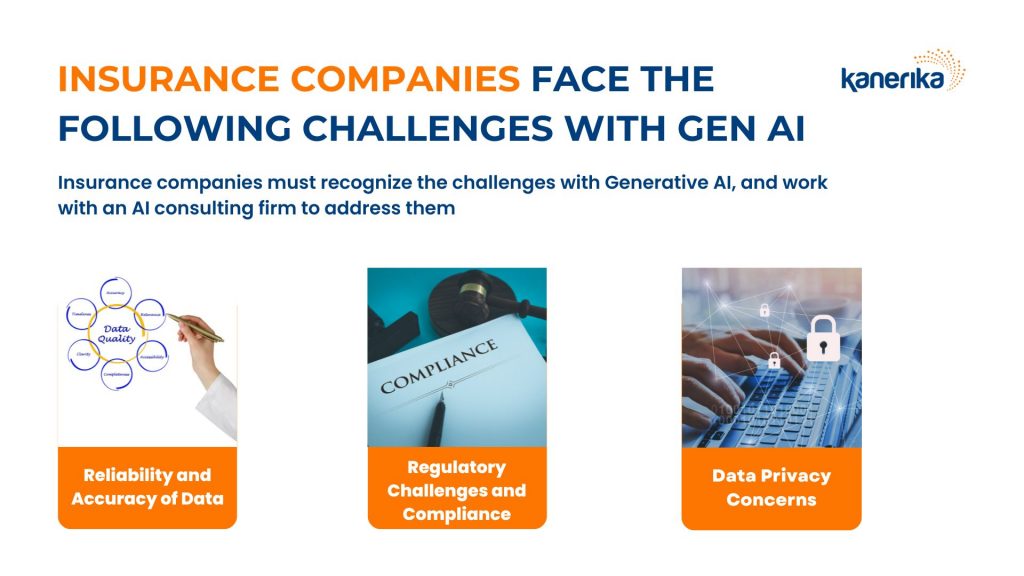
Implementing generative AI in the insurance industry’s existing business process presents several challenges. These challenges stem from the intricate nature of AI models, the sensitivity of the data involved, and the critical role of accuracy and compliance in the insurance sector.
Let’s explore them in more detail.
Read More – Microsoft Copilot vs ChatGPT: Choosing the Right AI Titan
Read More – Telematics in Insurance: How It Works and Benefits You
Challenge 1 – Reliability and Accuracy of Data
Generative models, while sophisticated, can sometimes generate outputs that are unrealistic or implausible.
This is particularly concerning in the context of insurance underwriting, where decisions are made based on the data provided. Inaccuracies in AI-generated data can lead to flawed risk assessments and predictions. This not only impacts the insurance company’s risk management strategies but also poses potential risks to customers who may be provided with unsuitable insurance products or incorrect premiums.
To mitigate these risks, insurance companies must implement rigorous validation and verification processes for AI-generated data, ensuring it aligns accurately with real-world scenarios and outcomes.

Challenge 2 – Regulatory Challenges and Compliance
Insurance companies face the challenge of ensuring their generative AI systems comply with existing and emerging regulations.
These regulations often focus on the robustness, fairness, and transparency of AI systems. Given the inherent complexities and sometimes ‘black box’ nature of AI models, demonstrating compliance can be challenging.
Regulators may impose specific requirements to ensure that AI systems do not inadvertently perpetuate biases or unethical practices. Insurance companies need to stay abreast of these regulatory changes and ensure their AI solutions are designed and operated in a manner that adheres to these regulations, protecting both their interests and those of their customers.
Challenge 3 – Data Privacy Concerns
In the insurance industry, where sensitive personal data is handled routinely – such as medical histories, financial records, and personal identifiers – data privacy is a paramount concern.
The integration of generative AI into insurance systems heightens these privacy concerns.
There is a risk of unintentional exposure or misuse of confidential information, which can have severe implications for both individuals and organizations.

Insurance companies must ensure robust data privacy measures are in place by securing data storage and transmission and ensuring data anonymization where necessary. Furthermore, they must comply with various data protection laws like GDPR, HIPAA, or other regional regulations, which dictate how personal data can be used and stored.
Failure to adequately protect data privacy can lead to legal repercussions, a loss of customer trust, and significant financial penalties.
Getting Started with Generative AI: A 5-Step Guide for Insurance Firms
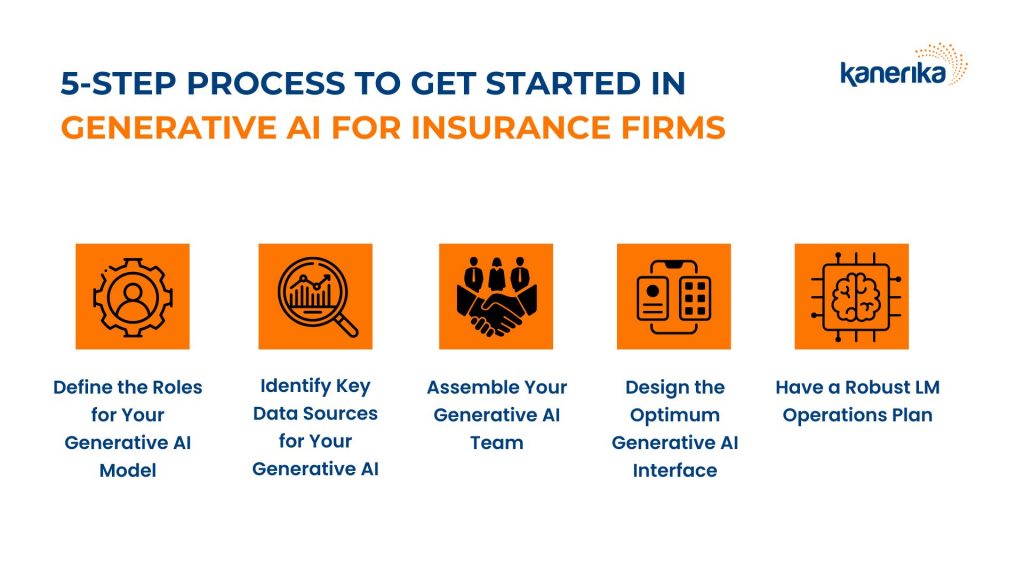
Navigating challenges in Generative AI implementation like accuracy, coverage, coherence, ‘Black Box’ logic, and privacy concerns requires insurance firms to follow a structured 5-step plan.
This approach, encompassing role definition, data sourcing, team assembly, interface design, and robust operations, is crucial for successful AI integration in the insurance sector.
Step 1: Define the Roles for Your Generative AI Model
In integrating generative AI in insurance, the first step is to identify roles that can benefit from enhanced productivity. Focus on positions that are difficult to retain and hire for, typically involving repetitive tasks.
For instance, in customer service, generative AI enables personalized customer interactions. By processing vast customer data, AI tailors insurance products to individual preferences, enhancing satisfaction and loyalty. AI-powered virtual assistants offer real-time help with policy inquiries and claims, improving customer engagement.
For risk assessment and underwriting, generative AI models bring efficiency and accuracy. They analyze historical data and patterns to predict risks more precisely, optimizing underwriting decisions and offering customized coverage, thereby reducing adverse selection risks.
Moreover, in claims processing, generative AI automates data extraction and validation from claims documents, streamlining the settlement process. This leads to quicker, more accurate claims resolutions, enhancing customer satisfaction and operational efficiency.
Step 2: Identify Key Data Sources for Your Generative AI
In the insurance industry, the effectiveness of generative AI largely depends on the quality and relevance of the data it is trained on.
The first task for insurers is to gather data from their core systems, a process that varies in scale and complexity. For larger insurers, this means mobilizing extensive resources to collect data across departments like claims and underwriting. It’s also crucial to incorporate third-party external data to broaden the data landscape, ensuring a comprehensive view.
Forbes notes that the next vital step is the deep cleaning of this data. The output quality of AI systems is directly linked to the quality of input data. Insurers need to meticulously filter out irrelevant information and correct errors, essentially preparing a ‘feast’ of high-quality data for the AI to process.
Finally, categorizing this clean and standardized data is crucial. By segmenting the data according to different business functions, insurers can enhance their analysis and application. For instance, properly categorized claims data can improve predictions about revenue reserves and risk assessments. This structured approach in data management is essential for leveraging the full capabilities of generative AI in the insurance sector.

Step 3: Assemble Your Generative AI Team
For insurance firms venturing into generative AI, assembling a specialized team is crucial. This team should ideally consist of a business expert with deep knowledge of the insurance industry, a prompt engineer to translate business needs into AI tasks, and a Machine Learning (ML) operations lead for technical execution and production.
As highlighted in the Generative AI CTO and CIO Guide For 2023 article, Kanerika’s expertise was instrumental in assisting an Asian insurance provider to overcome operational inefficiencies and compliance risks.
By leveraging generative AI models for automating data extraction, Kanerika not only streamlined the claim processing but also significantly enhanced customer satisfaction.
This case exemplifies the impact of a well-assembled generative AI team, combining in-house knowledge with external expertise, to drive innovation and efficiency in the insurance industry.

Step 4: Design the Optimum Generative AI Interface
For insurance firms integrating generative AI, designing an effective user interface (UI) and user experience (UX) is crucial. As the insurance sector becomes increasingly digital, the importance of intuitive and engaging UI/UX cannot be overstated. According to Adobe, 62% of UX designers use AI to automate tasks, enhancing productivity and user interaction.
In creating a generative AI interface for insurance, the focus should be on simplicity and efficiency.
For insurance firms, the focus should be on creating a generative AI interface that is intuitive and efficient. Incorporating chatbots into this design is crucial. Their design must be thoughtful, avoiding reinforcement of stereotypes and ensuring they address a wide range of customer queries.
AI empowers UI/UX designers to gather and analyze user data, uncovering patterns and insights into user behavior. This information is crucial for creating user-centered designs that cater to specific needs and preferences in the insurance process.
Step 5: Have a Robust Language Model (LM) Operations Plan
For insurance firms implementing ChatGPT, a robust Language Model (LM) operations plan is crucial. This plan should encompass infrastructure, performance upgrades, human oversight, and security. Moreover, key management discussions should focus on cost control, impact measurement, and continuous improvement.
ChatGPT, trained on extensive datasets, is invaluable for tasks like claims processing and customer service in insurance. Additionally, it can efficiently interpret and categorize complex text in claims documents, enhancing accuracy and efficiency. ChatGPT-powered chatbots provide personalized, real-time assistance in customer service, improving customer experience and operational efficiency.
Moreover, ChatGPT democratizes data analysis, enabling non-technical staff to perform complex analyses and make data-driven decisions. This broadens the scope of data utilization within the firm.
A comprehensive LM operations plan ensures effective integration of ChatGPT into the firm’s workflow, maximizing its potential while maintaining accuracy, security, and compliance with industry standards.
Top Generative AI Use Cases in the Insurance Industry
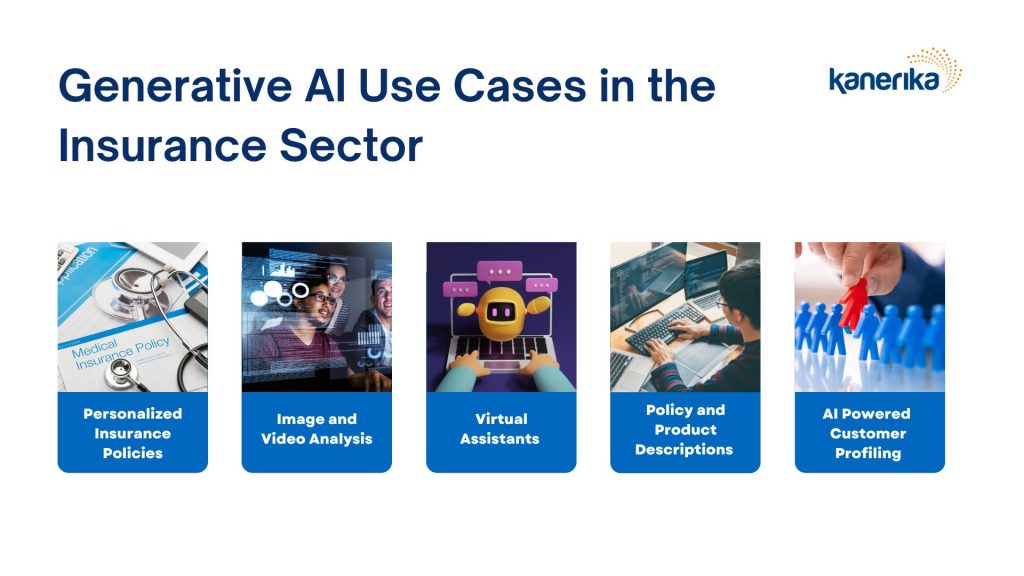
1. Personalized Insurance Policies Tailored to Individual Needs
The era of generic, one-size-fits-all insurance policies is over. Now is the time for personalized coverage tailored to individual needs. Generative AI models are at the forefront of this transformation.
By analyzing specific customer data points, such as age, health history, and location, these models can craft policies that align perfectly with individual circumstances. The result? More comprehensive coverage for the insured and heightened customer satisfaction.
2. Image and Video Analysis for Swift Claims Processing
The power of visual data is being harnessed like never before. Generative AI excels in analyzing images and videos, especially in the context of assessing damages for insurance claims.
Whether it’s a vehicular mishap or property damage, this technology facilitates swift claims processing and precise loss assessment. A real-world application can be seen with the Azure AI Vision Image Analysis service, which extracts a plethora of visual features from images, aiding in damage evaluation and cost estimation.
3. Virtual Assistants and 24×7 Customer Support
The customer-insurer interaction paradigm is undergoing a radical shift, thanks to Generative AI.
Advanced chatbots and virtual assistants, powered by this technology, are equipped to handle not just routine queries but also engage in intricate conversations. They can grasp complex customer requirements, offering tailored policy recommendations and coverage insights, thereby elevating the overall customer service experience.
Read more: How To Leverage AI Assistance For Business Growth: A 5-Step Guide
4. Policy and Product Descriptions
Generative AI is most popularly known to create content – an area that the insurance industry can truly leverage to its benefit.
AI’s ability to customize and create content based on available data makes it an extremely important tool for insurance companies who can now automate the generation of policy documents based on user-specific details.
Generative AI can create descriptions for insurance products offered by the company, which can help with marketing and product brochures.
5. Generative AI-Powered Customer Profiling
In an age where data privacy is paramount, Generative AI offers a solution for customer profiling without compromising on confidentiality. It can create synthetic customer profiles, aiding in the development and testing of models for customer segmentation, behavior prediction, and targeted marketing, all while adhering to stringent privacy standards.
For instance, Emotyx uses CCTV cameras to analyze walk-in customer data, capturing details like age, dressing style, and purchase habits. It also detects emotions, creating comprehensive profiles and heat maps to highlight store hotspots, providing businesses with real-time insights into customer behavior and demographics.
Case Studies of Successful AI Implementations in Insurance
In the first instance, a leading insurance company grappled with assessing financial health, vulnerability to fraud, and credit risk management.
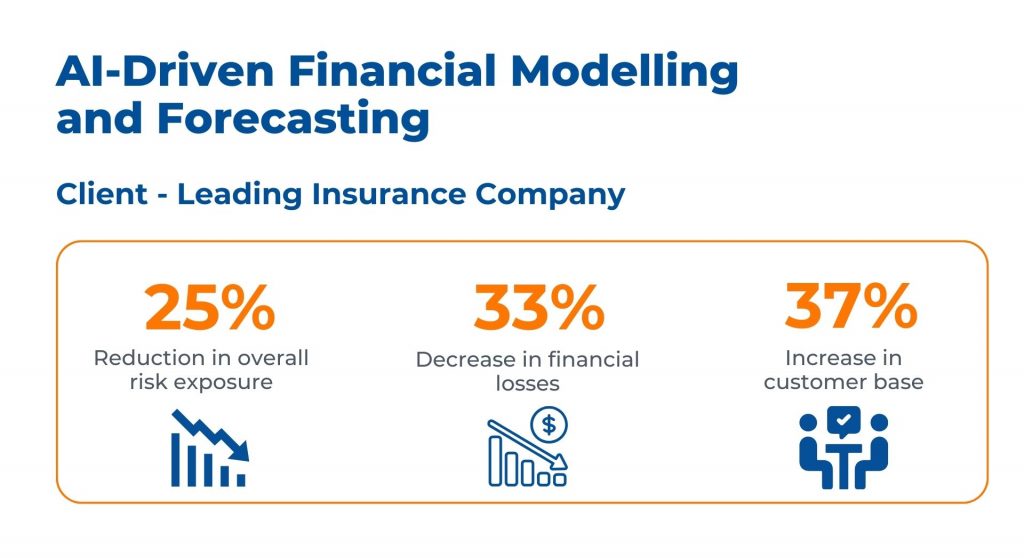
Kanerika’s intervention involved deploying advanced AI data models for comprehensive financial analysis, which facilitated informed decision-making for growth.
The use of Machine Learning algorithms like Isolation Forest and Auto Encoder significantly reduced fraud activities. Additionally, sophisticated financial risk assessment models can identify and mitigate potential risks.
The outcomes were a 25% reduction in risk exposure, a 33% decrease in financial losses, and a 37% growth in the customer base, marking a substantial improvement in operational efficiency and financial health.
Following this, a global insurance leader faced challenges with manual data integration, leading to errors and potential compliance risks.

Kanerika addressed these issues by automating data extraction with Kafka and standardizing data using Talend. AI models such as TensorFlow and PyTorch can streamline the integration process.
This strategic implementation resulted in a 22% increase in customer satisfaction, a 29% reduction in fraud, and a 37% decrease in claim processing time, significantly enhancing the company’s operational efficiency and customer service capabilities.
Kanerika: Building the Future of Insurance with Generative AI
Generative AI’s transformative potential in insurance operations is undeniable, offering solutions from conversational finance to algorithmic trading.
However, navigating and implementing the generative AI maze in your organization’s framework takes experience and insight. From choosing the best security protocols to creating advanced algorithms, companies need to pick the right AI consulting partner.
With years of experience in data management and AI/ML, Kanerika offers robust, end-to-end solutions that are ethically sound and compliant with emerging regulations.
As the future beckons, partnering with Kanerika ensures you’re ahead of the curve, leveraging cutting-edge solutions. Dive into the future of generative AI in insurance with us.

FAQs
How does generative AI differ from traditional AI in insurance?
Unlike traditional AI systems that produce predictable and consistent outputs based on input data and predefined rules, generative AI focuses on creating new data that does not already exist in the training dataset.
What is generative AI in insurance?
Generative AI in insurance is a technology that uses algorithms and models specifically designed for generating new content, such as images, music, and text, to reimagine and rearchitect long-standing insurance processes.
What are some platforms and tools available for training and deploying generative AI models in insurance?
Some platforms and tools available for training and deploying generative AI models in insurance include OpenAI’s GPT-4, Google’s Bard, HuggingFace’s Transformers, and TensorFlow.
What is GenAI in insurance underwriting?
In insurance underwriting, GenAI refers to the application of generative AI to enhance risk assessment accuracy. This is a significant topic in generative AI for business leaders, focusing on analyzing data for better policy pricing and coverage decisions.
What are some potential risks and limitations of generative AI in insurance?
Potential risks and limitations of generative AI in insurance include the need for large amounts of training data, high computational resources, potential bias in generated content, and difficulty in controlling the generated output.
How does ChatGPT affect the insurance industry?
ChatGPT, a model of generative AI for enterprises, impacts the insurance industry by automating customer interactions and claims processing steps, enhancing efficiency and customer satisfaction. It's a key tool for those learning how to get started in generative AI for business.
How can insurance leaders integrate generative AI into their business processes?
Insurance leaders can integrate generative AI into their business processes by starting with a sense of curiosity, experimenting with different prompts, exploring various outputs, and observing how slight changes in input can lead to different results. They can also look to people and businesses who are a few steps ahead in their AI journey for guidance and resources.
What is generative AI for claims processing?
Generative AI for claims processing involves using AI to automate the claims handling process, a core topic in generative AI business strategy. This includes data extraction, damage assessment, and automated decision-making, leading to more efficient claims resolution.